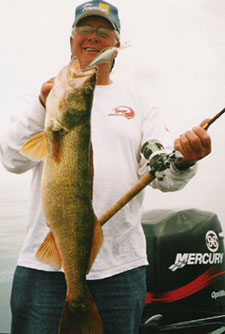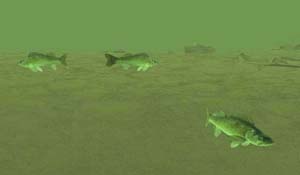
A Midwestern summer is many things to many people.
It’s picnics, family reunions and vacations. It’s swimming, sunbathing, boating and camping. It’s lemonade, iced tea, watermelon, sweet corn and popsicles.
Those of us who love to fish for walleyes know it’s also a season when walleyes have places to go and things to do.
That local weed patch that produced fish from May through early July is yielding fewer and fewer walleyes and more and more questions for anglers. Did we fish out the weeds? Do we need to change tactics? Did the walleyes simply move elsewhere? If so, where did they go?
Fortunately, if we know nothing else about summer walleyes we know this: Nearly everything a walleye does is related to its ability to feed its face efficiently and frequently.
Those old weedbeds offered a full menu of entrees earlier in the open-water season. In fact, vegetation is where the circle of aquatic life begins. Aquatic insects and fry can feed on plankton. Larger baitfish can feed on the bugs and newly hatched fish. Crawdads, salamanders, frogs and leeches thrive, too. Meanwhile, the underwater jungle provides a cloak of security.
Eventually, those smaller species of fish grow to a size where they need more sustenance than the weeds can provide. So, they become more adventuresome and seek out new food sources.
So do the walleyes. They are more willing to travel, especially if there’s a good picnic spread somewhere along the journey. And because of the warmer water temperatures that increase their metabolism, they must feed more frequently than they do at most other times of the year.
The challenge isn’t catching these hide and seek walleyes, it’s finding them. They can be on breaklines, mud flats or suspended in open water. They can be attracted to anything from bug hatches and the presence of mud worms to schools of shad, minnows, chubs and perch.
When my favorite weed beds seem to be drying up, one of the first places I explore are the closest breaklines and the outside edges of the weeds, which are easy to identify and locate with my Humminbird 997cSI side-imaging sonar unit.
Choose a rig and presentation that you can fish effectively in these areas where the vegetation is still present, but far less dense.

My go-to set-up consists of a Lindy No-Snagg sinker and spinner rigs tipped with Berkley Gulp! minnows or grubs in the 3- or 4-inch size. Run the sinker up your line, tie on a barrel swivel to serve as a sinker stop, then use a lead for your spinner rig that’s at least six feet long. You can also rig this presentation on a three-way.
Make the Gulp! weedless by running a 1/0 hook through the nose, then flipping the bait upside down and pushing the barb through the body until just the tip is showing. The advantage of using Gulp! is twofold: Not only does it attract walleyes with its revolutionary scent dispersal, but it will keep you fishing when pesky, live bait-thieving species like perch and bluegills are present.
Because these breaklines and edges closest to the weeds are typically in relatively shallow water, it pays to be stealthy. I let my MinnKota 101 Terrova pull me along the edge, moving as fast as 1.0-1.5 mph until I contact fish. Then I will slow down and work the fish over at 0.8-1.0 mph.
I never leave these areas without trying a more aggressive approach, too. A Berkley Frenzy Flicker Shad trolled at about 2.5 mph will often entice strikes from otherwise noncommital fish. To cover a wider area, use an Off-Shore planer board to take a second line away from the boat.
If I don’t find walleyes along the breaks and weed edges, I begin exploring the adjacent open water for suspended fish. Again, the Humminbird’s side-imaging technology gives me the advantage of being able to spot fish in the middle of the water column at the same time I’m watching the bottom. Many anglers never know that suspended walleyes are present because those fish scatter when a boat approaches and don’t show up on sonar.
When I find suspended fish, I take note of the depth they are holding so I can be sure to run at least one of my baits, if not all of them, just a foot or two above them. Because their eyes are positioned on the top of their heads, walleyes tend to feed up and seldom go after baits below them.
Depending on the depth of the fish, I set up with No. 5 or No. 7 Flicker Shad baits and troll them on planer boards to get them away from the boat. My Yamaha T-8 kicker motor works well for me at speeds ranging from 2.0-2.5 mph in early summer to 2.5-3.5 mph later in the year, but I have friends who don’t hesitate to troll with their big Yamaha four-stroke outboards.
These fish are usually aggressive enough to chase down a fast-moving crankbait.I like a good summer picnic as much as anyone, but I prefer mine to include a few golden brown walleye fillets. It’s just a game of hide and seek.










